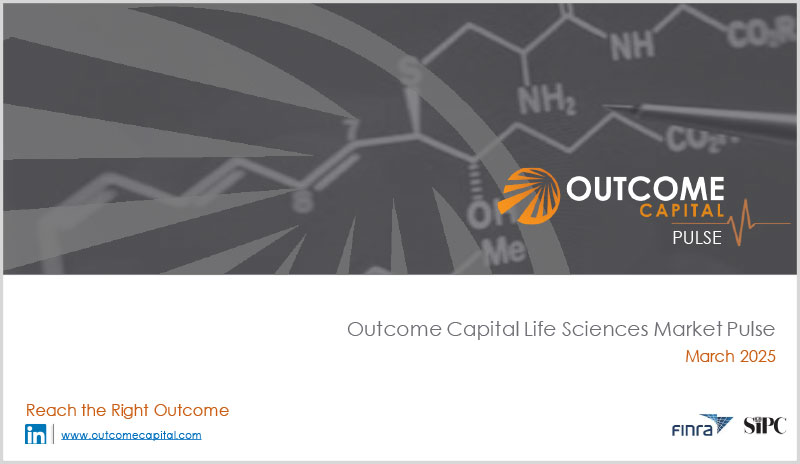Caught By Surprise: The Diagnostic Industry in The Time of COVID

Caught By Surprise: The Diagnostic Industry in The Time of COVID
By: Craig Steger and Oded Ben-Joseph
As a life science advisory and investment banking firm, Outcome Capital has been following the unprecedented events of COVID-19, with specific focus on the impact on the in vitro diagnostic (IVD) segment.
Several questions have come to mind – 1) How will the pandemic change the mindset of investors or acquiring companies towards life sciences and IVD companies? 2). How will the COVID-19 economy affect transactional activity?
World markets are looking to the pharmaceutical and diagnostic industries to solve the COVID pandemic. They have been tasked with diagnosing and monitoring the disease, treating acute patients, preventing further spread, and preparing us to limit infection recurrence this fall. Unfortunately, the IVD industry did not head into this pandemic at the top of the scientific investment landscape.
Diagnostic Didn’t Start at the Top
Last fall, Outcome Capital conducted extensive research into the transactional history specifically within the IVD marketspace from Q1 2016 through Q3 2019 (Outcome Capital Market Insight, https://www.outcomecapital.com/resources/in-vitro-diagnostic-market-insight-continued-growth-and-consolidation). It was clear that the IVD industry received a relatively small amount of investment dollars compared with other life science segments such as biotech and pharma. In fact, the IVD segment received just 3% of all life science venture dollars during this time frame. Several other key findings and observations:
- Many transactions involved industry consolidation by major market players
- A vast majority of M&A’s occur post regulatory approval and early commercial traction.
- Companies that offer platform technologies (reagents & instruments) or provide laboratory services dominate the landscape
These observations, in both financings and M&A activity, continue to hold true. Analysis of Q4’19/Q1’20 activity have shown only ~$360M global venture dollars invested in either early or late stage IVD companies with an average of $14.7M (only 25 transactions with data) compared with ~$750M invested in biotech or pharmaceutical companies in the United States.
Q4’19/Q1’20 saw two large industry consolidations – Exact Sciences acquisition of Genomic Health for $2.8B and the announced acquisition of Qiagen by ThermoFisher for $11.5B. Additionally, of the six mid-market acquisitions, five had regulatory clearance and all had commercial traction for their technologies or services.
While these acquisitions have resulted in healthy returns for investors, the trend of minimal investment dollars going to the IVD marketspace puts these companies at a disadvantage, as limited capital leads to limited access to talent and resources. We argue that these constraints have limited the innovation of the industry over the past few decades.
The COVID Economy:
COVID testing has brought a spotlight back to the IVD industry that has not been seen since the mid-80’s with the emergence of HIV and potential contamination of the world blood supply. The IVD market, and infectious disease-related testing, will likely see renewed investment. A recent Pitchbook report1 already suggests an up-tick in interest by venture firms looking at life science-based investments. However, translation into a larger number of transactions within this space will be a longer-term event that requires recovery of the COVID economy.
On the surface, it seems that in the short-term COVID should have tremendous positive impact on IVD revenues but we have to remember that nucleic acid testing (NAT), alternatively known as molecular diagnostic, used for COVID-19 infection testing is only a sub-segment of the total IVD market.
Molecular-based COVID-19 screening is currently in huge demand and will continue to increase as the global community continues to fight the immediate pandemic and monitor for future outbreaks. This had already led to a modest increase in revenue within this sub-segment. Serum testing for anti-COVID antibodies in individuals using protein-based diagnostics (immunoassays) has begun in earnest and will continue to rapidly increase as we look to reopen our economy, which will again translate to enhanced revenue both near- and mid-term.
To-date, however, total IVD revenue has been negatively impacted by the COVID pandemic2. With elective or non-essential procedures being postponed, most IVD testing is dramatically reduced. Additionally, COVID shelter-in-place policies are leading to reduced commercial efforts and customer outreach such as postponed product launches and lower marketing spend. We believe lower revenues, in combination with the general COVID-induced stock market downturn may limit IVD transactional activity in the short-term. Long-term, however, the major role diagnostic-related efforts are playing in fighting the pandemic should provide the exposure needed to bump IVD up in the minds of investors and strategic acquirers.
Investing In The Technology Leap:
The renewed attention on the diagnostics segment has revealed a lack of recent innovation. As of May 8th, there have been 159 companies with Emergency Use Approvals from the FDA for COVID tests. Sixty (60) independent tests focus on serology or antibody based, while the remaining assays are molecular based3. Many of the techniques underlying COVID testing were developed in the 1980’s. While these older approaches have been modified and updated to create robust platforms that serve to accommodate routine clinical needs, major leaps in technology advancements have not taken place.
The rapid testing and treatment required to handle pandemics, such as we have seen for COVID-19, highlights the need for versatility, ease of use, throughput, and reagent and instrument availability that most current platforms for routine clinical testing simply can’t meet. Thus, the IVD industry will be looking for innovation – the next generation of technologies and platforms to combat rapidly emerging infectious agents.
In the end, we believe COVID-19 has shown both the general public and investors that pandemics are real, their impacts on health and the economy are devastating, and it is through renewed innovation in pharmaceutical and diagnostic research and development that we find relief.
References:
- https://pitchbook.com/news/reports/q1-2020-pitchbook-nvca-venture-monitor
- https://www.iqvia.com/about-us/commitment-to-public-health/covid-19-resources
- https://www.360dx.com/coronavirus-test-tracker-launched-covid-19-tests
Resources
A Shifting Market Environment and Strategies Fueling Innovation in Prostate Cancer Treatment
Blockbuster drug patent expiration, advances in enabling technology, and the emergence of personalized medicine for prostate cancer treatment create a landscape worth examining.
DownloadResources

Outcome Capital Life Science Market Pulse, March 2025
Outcome Capital Life Science Market Pulse March 2025 Click to view our LifeSciences Pulse Newsletter
DownloadContact Us for More Information
Would you like to learn more about working with Outcome Capital or discuss your specific needs?


